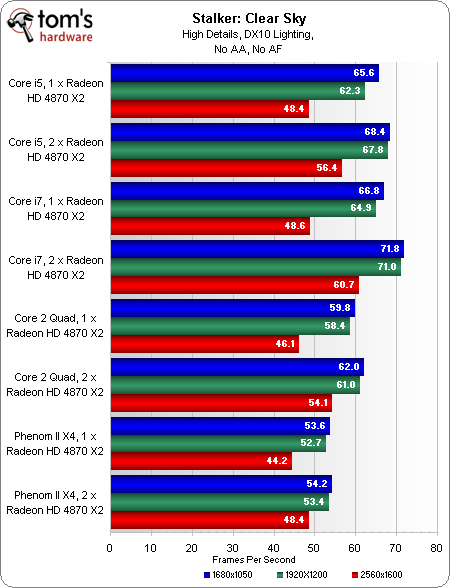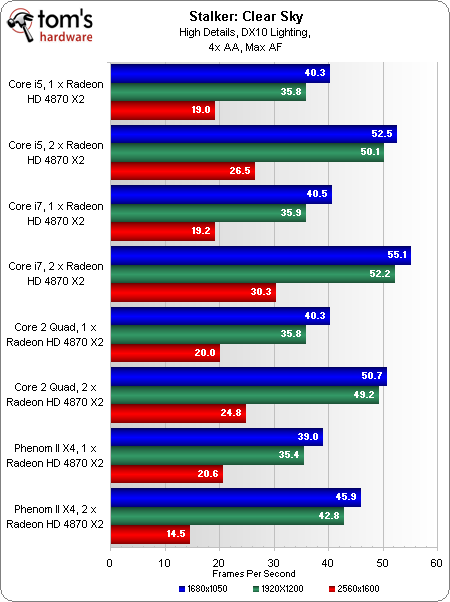In Theory: How Does Lynnfield's On-Die PCI Express Affect Gaming?
Benchmark Results: Stalker: Clear Sky
Our first game test hammers graphics performance. With one graphics card installed, the Core i5 is unable to translate its advantage in 3DMark Vantage into a win over Core i7. The pricier platform edges out the newcomer—its two advantages are Hyper-Threading and three channels (rather than two) of DDR3 memory.
Core i5 does best the slightly higher-clocked Core 2 Quad by a fairly substantial margin, though, with a lead that shrinks as resolution increases. It puts an even bigger gap between itself and the 2.8 GHz Phenom II.
Dropping a second card into our test platforms does very little for performance at 1680x1050 or 19200x1200—a result of our relatively slow CPU clocks holding back performance. Let’s look at the red bars instead, representing 2560x1600. First up, Core i5 versus Core i7. The even result between these two platforms with one graphics card installed suggests that one 4870 X2 isn't enough to flesh out differences between the two. With a pair of cards, the i7 takes a quantifiable lead. Clearly, dividing PCI Express up into x8 slots is hurting i5. Is the difference palpable in the real-world? Almost certainly in this case, it is not.
Once again, i5 puts in a couple of frames above and beyond Core 2 Quad and a few more on top of AMD’s Phenom II—both platforms clearly limited by their host processors at lower resolutions (thus, you see CrossFire adding zero performance).
Anti-aliasing adds a significant graphics workload, partially mitigating the CPU bottleneck experienced previously.
With one card installed, i5 and i7 achieve almost exact parity. And for that matter, Core 2 Quad and Phenom II are remarkably close as well, suggesting a single Radeon HD 4870 X2 is now the component holding us back.
Add the second card and the range opens up a bit. Core i5 once again trails i7 when its PCI Express lanes get divided up between two powerful video cards. The same happens to Core 2 Quad and Phenom II, though, so it’s not really a surprise to see i5 besting both platforms at 2.8 GHz.
Get Tom's Hardware's best news and in-depth reviews, straight to your inbox.
Current page: Benchmark Results: Stalker: Clear Sky
Prev Page Benchmark Results: 3DMark Vantage Next Page Benchmark Results: Crysis

